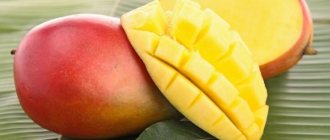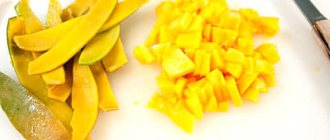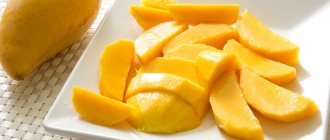12/08/2019 Maria Ivanova 0 comments
The aromatic mango can not only be eaten fresh, but also added to dishes such as salads and sauces. But before you start making culinary masterpieces, you need to understand how to peel a mango and remove a large seed. It turns out that this requires special knowledge and skills.
A little botany
Mango is the fruit of an evergreen tree that grows in tropical and subtropical climates. India, or more precisely the province of Assam, is considered its homeland.
The fruits of the exotic plant are quite large (400-450 g), oval in shape, covered with a thick peel. The peel can have different colors: yellow, red, black, green, red or brown-green. It all depends on the plant variety. The pulp is juicy, aromatic, and has a rich yellow or orange color.
The fairly large hairy bone, which is hidden inside the fruit, is very difficult to remove without special skills.
Brief description of how it is beneficial for the body
The homeland of the exotic fruit is India, or rather its humid tropics. The weight of one fruit is approximately 400 grams. It is covered with a smooth yellow, reddish, greenish, and sometimes purple thin skin. The pulp is fibrous, inside it there is a flat bone. The color of ripe pulp is orange or yellow.
Mango has an oval shape, slightly thinned on one side, slightly expanded on the other side. There are thickenings or “cheeks” on both sides of the fruit. To choose the right quality product, you need to lightly press on the thickenings. The pulp of a ripe fruit is soft but elastic. It has a strong spicy aroma, and the riper it is, the stronger the aroma.
The pulp is suitable for consumption. The bones are separated and discarded. The peel can be eaten, but since it has a specific taste and is also tough, it is usually removed.
Both ripe and unripe products have beneficial properties. Mango is a source of many beneficial substances.
He is endowed with:
- carbohydrates;
- proteins;
- fiber;
- ascorbic acid;
- vitamins A, B, D;
- microelements: potassium, calcium, phosphorus, manganese, iron;
- organic acids;
- carotenoids;
- tannin.
Of course, such a product is useful for both adults and children.
Regular consumption of it promotes:
- increasing the protective properties of the body;
- preventing the development of colds;
- normalization of the central nervous system: combating stress, tension;
- improving mood;
- improving performance;
- improving vision;
- cleansing the body of toxins and toxic substances;
- getting rid of extra pounds.
Benefits of mango for the body
It is believed that mango not only has an excellent taste, but also benefits the body. This has been proven by specialists from India, Australia and America who conducted research. Over the years, the fruits of the plant, as well as the leaves and bark of the tree, have been successfully used to treat various diseases.
Mango has proven itself in the treatment of diabetes. Regularly eating the juicy fruit can lower your blood sugar levels. An extract based on mango peel also effectively fights diabetes.
By eating the bright fruit, you can not only get a portion of vitamins, but also normalize your blood pressure and reduce the risk of heart disease.
Vitamin B6, which is part of this product, improves brain function. This same vitamin, together with the others belonging to group B, lifts your mood and improves your sleep.
Vitamin K and calcium, which are abundant in mangoes, help strengthen the musculoskeletal system. By consuming a tasty fruit, a person simultaneously minimizes the possibility of bone fractures.
Photo: https://pixabay.com/photos/mango-fruit-colorful-food-fresh-1239347/
Also mango:
- helps eliminate constipation;
- relieves diarrhea;
- reduces the possibility of asthma;
- treats iron deficiency anemia;
- fights the aging process;
- is an ally in the fight against excess weight;
- improves digestion;
- fights cancer.
By regularly eating mangoes during menstrual periods, women will reduce the risk of iron deficiency.
This fruit is also recommended for pregnant women.
Vitamin E in combination with beta-carotene increases sexual desire in men, improves potency and sperm quality.
Mango is also effectively used in cosmetology for the preparation of creams and masks for the face and hair care products.
When eating mango, you should also consider the following contraindications:
- fruit can cause dermatitis;
- not recommended for people with kidney problems;
- causes allergic reactions in people with hypersensitivity;
- patients with pancreatitis should eat mango with caution;
- It is not combined with alcoholic beverages in any form.
Mango calorie content is 67 kcal per 100 g of product.
Is mango peel edible?
The skin covering the mango is required to protect it from external damage. It is dense and strong, which allows the fruit to be delivered to customers all over the world without loss of quality.
Because mangoes are related to poison ivy, their peel contains a toxic substance called urushiol. In large quantities it can cause serious harm to health. Despite the fact that the peel of one fruit contains very little substance, it can cause a lot of harm. Therefore, it is not recommended to eat the peel.
People prone to allergic reactions should not even touch the mango skin (eat the fruit only after consulting a doctor). For them, this can lead to skin blisters and burns.
How to choose a ripe fruit
In countries where mangoes are grown, it is almost impossible to purchase unripe fruit: only ripe, aromatic fruits are displayed in shops and in the stalls of street vendors. Everything is more complicated for us.
The fact is that the fruits are picked unripe so that they can travel long distances. As a result, the fruits that reach us may not always be ripe.
To avoid bringing home a mango that you can’t eat right away, you need to know some “tricks”:
- the surface of the fruit should be elastic, but not hard;
- A ripe mango smells, but an unripe fruit has no smell at all. Interesting! The mango smells strongest at the tail;
- the ripened fruit should be even, shiny and smooth. The peel should not have dents or other damage;
- There are small dark specks on the peel of a ripe mango;
- the weight of the fetus is more than 200 grams.
Small fruits are likely to be unripe. But the very large size of the fruit does not guarantee that it is ripe.
The criterion for choosing a fruit should not be the color of the peel! A green fruit may turn out to be juicy and tasty, but a red fruit may turn out to be green and inedible.
Does it need to be cleaned?
Oddly enough, sometimes this question arises. Mango skin is usually three colors: green, red and yellow. Completely tasteless and useless. In addition, according to research, it is the peel that contains the substance urushiol, which causes skin allergies.
Harmful substances accumulate in the peel of the fruit. Therefore, during cleaning, it, like the pit, should be removed.
Important: if an allergy appears on your hands after contact with mango peel, this does not mean that you cannot eat the peeled fruit. This only proves that the peel of the fruit is not only useless, but also dangerous for you personally. So next time, before you peel the fruit, wear gloves.
Mango peel is thick, elastic, tasteless and completely useless for the body.
Another important point is that when purchasing fruit in a supermarket, you cannot know what it was treated with so that it retains its “marketable appearance” for as long as possible. And this is another argument in favor of peeling mangoes before eating.
How to peel a mango and remove the pit - all the ways
In addition to the tasty pulp, the fruit has a hard peel with a specific taste, which not every person will like. Therefore, before eating mango, you need to get rid of it.
Often, eaten peels lead to indigestion. It is also a powerful allergen.
And there cannot be complete confidence that the fruit brought from afar was not treated with any harmful chemicals during transportation. Therefore, we must remove the peel.
You will also have to perform one more maneuver: get rid of the bone.
With a knife
Let's figure out how to peel a mango. If the fruit is mature and firm enough, you can use a standard kitchen knife, proceeding in the same way as when peeling regular potatoes. The peeled fruit must be cut lengthwise and, rotating the halves in different directions, separate them from the pit.
The knife must be sharp.
You can separate the pulp from the stone by using a knife and simply cutting off the mango halves. You need to cut as close to the bone as possible. The pulp remaining on the sides is cut off in exactly the same way.
Photo: https://pixabay.com/photos/mango-tropical-fruit-juicy-sweet-642957/
Let's look at another way to peel a mango, but let's note right away that it requires skill and you may not be able to implement it the first time. You need to cut the halves of the fruit and remove the pit. Place the resulting mango “petals” with the flesh facing up and make cuts on them with a sharp knife. The cuts should look like a mesh, but not touch the peel. Next, take half a mango, turn the flesh out and carefully cut it off.
During these manipulations, the mango will release a lot of juice.
Therefore, it is better to perform all actions over a bowl so as not to lose the delicious drink. The fruit must be washed very thoroughly before starting.
The juice is very difficult to wash off, so you need to clean the fruit very carefully so as not to splash your clothes and everything around.
How to properly peel a mango that is not ripe? It is better to use a vegetable peeler for this purpose. But there is another way to peel overripe fruit. Having made a cross-shaped cut at the top of the fruit, going 5 mm deep inside, then you just need to grab the edge of each “petal” and remove it from the fruit by simply pulling it down.
Spoon
An ordinary spoon, preferably a tablespoon, will help you cope with mangoes. True, the fruit after such manipulations will have a very unattractive appearance. But believe me, its taste will not change for the worse at all.
So what are our actions? We cut the well-washed and unpeeled fruit by running a knife around the circumference. We insert a spoon into the resulting cut on either side, apply pressure and, as it were, “remove” the half, separating it from the bone hidden inside. You can also remove the bone from the other half with a spoon.
You can get tasty pulp from the existing halves using the same “tool of labor”, simply by scooping it out and putting it on a plate or directly in your mouth.
How to cut a mango if you need it to prepare a dish? Here you don’t have to bother at all. The fruit is cut into slices without even peeling the outer shell. And then the pulp is removed from these slices with a spoon, which is sent for further processing.
Using glasses
Another very popular method for pitting mangoes is to use a glass.
You need to cut half a mango, making a cut as close as possible to the center, that is, to the bone. Take the half in which the bone remains and bring it to the glass vessel. Use the edge of the glass to lightly pry the bone and press on it. The glass will go into the pulp, and the inedible part of the fruit will simply fall into the glass.
The glass will also help separate the pulp from the mango peel. The unpeeled mango must again be cut in the same way as described above: as close to the base as possible, resulting in two “cheeks”. One by one, bring each “cheek” to the glass and, placing the edge of the vessel between the pulp and the peel, apply pressure, passing the glass along the entire length of the fruit. The edible aromatic part will fall into the glass, and the peel will end up outside the container.
Using a mango cutter
Nowadays, you can buy an interesting device - a mango cutter.
If you are a fan of this fruit, but do not want to waste time removing the seed, you should take advantage of the achievements of science and technology. The mango cutter is easy to use; with its help you can very quickly cut the fruit and remove the pit.
Photo: https://pixabay.com/photos/mango-hd-mango-mango-fruit-2360551/
But in fact, peeling a mango is only difficult the first time. Knowing the necessary “tricks” and practicing a little, you can become an expert in this matter and not pass by an attractive fruit in the store.
The mango seed should not be thrown away. It can be planted in a flower pot.
After some time, you will have a mango tree in your apartment. True, an ungrafted tree is unlikely to bear fruit at home, but in itself, without fruit, it has a very aesthetic appearance.
What to do with the bone?
Mango seeds have a wide range of uses.
They can be used for various purposes, for example:
- Plant in a pot. The seeds of the tropical fruit take root completely and grow well at home. At the same time, they are not picky about care.
- Use to create a skin scrub. To do this, you will need to initially rinse well and then dry the seeds so that they are clean. Next, the product should be ground into flour and supplemented with cinnamon, bee honey and a few drops of essential orange oil. The result is a thick, mushy mass that helps eliminate stretch marks and cellulite. This scrub helps make the skin smoother and more elastic.
- Use for making nourishing masks. This product will help improve your complexion and keep your skin toned. To create a mask, you will need to split the seed and remove the core. After this it needs to be crushed. The resulting composition is mixed with olive oil and then applied to the face and neck.
- Use to make a drying tonic. This homemade cosmetic product is suitable for caring for problematic facial skin. To create it, you only need the core of the seed, which must be dried in the oven for 70 minutes. Then the kernel must be cooled and ground into powder. After this, the mass is supplemented with alcohol and infused in the refrigerator compartment for 5 days. During this period of time, the composition must be stirred periodically. Then the liquid will need to be filtered and diluted with clean water in a 1:1 ratio, respectively. This product should be applied specifically to problem areas of the skin.
- Use to make oil. To create it, you only need the seeds contained inside the seed. The oil, prepared from the seeds of a tropical fruit, well nourishes and moisturizes rough and dry areas on the skin of the face or body.
Mango has very juicy, tender and tasty pulp that can be added to almost any dish. However, to try it, you will first need to cut the fruit and remove the pit. The cleaning process is quite labor-intensive, but there are several easy ways that will help you easily and quickly remove the peel and pit from the fruit without damaging the pulp.
How to cut a mango - all the ways
Sometimes you need a fruit not only to be tasty, but also to look beautiful on the table. To achieve this, you need to know how to cut a mango to surprise your guests.
Hedgehog
The easiest to perform is the “hedgehog” method. How can we turn a tropical fruit into a prickly animal?
First, use a knife to cut off the “cheeks” of the mango. Then you need to make cuts on the flesh of each “cheek” with a knife: first parallel lines, then perpendicular.
The cuts should be deep enough without damaging the skin.
It's up to you to decide at what angle to make the cuts, draw diamonds or squares.
Then you need to pick up the “cheek” with the cuts and, pressing from the side of the peel, simply “turn” it out. A bristling hedgehog can be placed in a place of honor to decorate a dish or a plate of fruit.
Plates
Those chefs who masterfully work with a knife can create real works of culinary art by cutting mangoes into slices and using them to subsequently make various shapes.
Let's look at how to cut mangoes into slices. Carefully holding the fruit, you need to cut off fairly thin plates using a sharp knife. The plates can be either approximately the same size or different. You can use them to create gorgeous roses and other decorations. A prerequisite is the preliminary peeling of the fruit.
How to eat properly
The fruit can be consumed raw, or can be used to make salads and healthy smoothies. The pulp is indispensable for making juices, cocktails, and purees. They also make chips from it.
It is an ingredient in seasonings and sauces: achar - the pulp is crushed and then marinated along with vegetables, chutney - a pulp puree is stewed and then mixed with hot spices.
It can be used as an addition to main dishes. It goes well with seafood. They make ice cream from it - crush it into cubes and then freeze it.
A milkshake is made from unripe fruits - the pulp is crushed in a blender and then mixed with milk.
How to eat mangoes - rules and options for use
How to eat mango correctly? There are several options for consuming juicy fruit:
- Remove the pit from unpeeled mango. Diamonds are cut out on the “cheeks”, pressed from the side of the peel, “turning out” the pulp. Place the halves in this form on a dish and eat, separating the pieces with a fork;
- the fruit, peeled from the not entirely edible shell, must be separated from the pit, cut into cubes, placed on a plate and eaten, taking the pieces with your hands or a fork;
- You can eat mangoes by using a tablespoon and scooping out the juicy pulp from the unpeeled halves.
By eating unprocessed fruit in the form in which Mother Nature presented it to us, you will get the maximum amount of vitamins.
If the mango fruit is cooled before use, its taste characteristics will increase.
What can you eat mango with?
Mango is a real source of inspiration for experienced and novice cooks. It is suitable both for serving fresh and as a component of salads, appetizers and sauces.
Mango salsa perfectly complements chicken with rice and vegetable salads. It is prepared like this:
- Mix the pulp of 4 ripe mangoes, 1 red pepper, and half an onion.
- Add red pepper, 2 cloves garlic, ground ginger, apple cider vinegar, half a glass of lime and a little sugar.
- Bring to a boil and cook for 10 minutes.
In addition to making sauces, mangoes are great for adding to salads, both fruit and vegetable. The taste of the salad, which includes salmon or feta cheese, is especially interesting. In addition, it can be eaten in its pure form as a dessert.
Useful tips
If it turns out that you bought a mango and did not eat the fruit right away, it is best to store it in the refrigerator. Nothing will happen to an unripe mango in the fruit and vegetable department even in 10 days, but it is not recommended to store ripe fruits for more than 5 days.
Even if you were given a mango in a plastic bag at the store, you need to get rid of the packaging when you get home.
The bag promotes the formation of mold and impairs the taste of the fruit.
Photo: https://pixabay.com/photos/mango-fruit-still-life-1534061/
In order to preserve mangoes for a long time, you need to freeze them by cutting them into pieces, squares or slices and placing them in special bags.
It is better to make small portions; thawing the mango and freezing it again is not recommended.
After such manipulations, the exotic fruit will not only acquire an unattractive appearance, it will also lose all its taste appeal.
It also makes no sense to even try to store an already cut mango for a long time. The fruit releases juice abundantly and will become unfit for consumption after 2-3 hours.
What to do if you become the “lucky” owner of an unripe fruit? Do not be sad! And make the fruit ripen at home. To do this, you need to purchase a paper bag and place the mango there along with a ripe apple or banana. Cover the bag a little and leave it in the room for five days.
Covering the fruit with rice or corn also gives excellent results. Place the mango in a deep enough container and completely cover it with grains. After 7-9 hours, mangoes can be eaten.
What to cook with mango
Mango is wonderful on its own. But in combination with certain ingredients, the taste and aroma of the fruit are revealed in a new way.
Mango jam
Ingredients
- 2–3 mangoes;
- 200 g sugar;
- 60 ml water;
- 1 teaspoon grated lemon zest;
- 1½ tablespoons lemon juice.
Preparation
Puree the mango pulp in a blender. Pour sugar into a saucepan, add water and place on low heat. Cook, stirring, until sugar dissolves.
Combine the syrup with mango puree. Add the zest, stir and cook for 2-3 minutes. The jam should bubble a little. Pour in the lemon juice and cook, stirring, for about 15 minutes until the mixture thickens.
Drop a little onto a plate and tilt it. If the jam does not run out, it is ready. Store the dessert in a closed container in the refrigerator for no longer than two weeks.
Experiment











